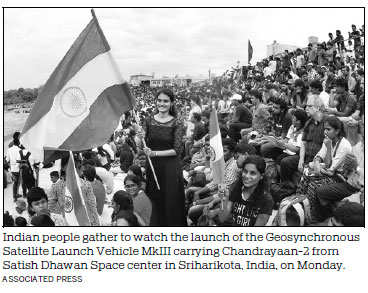New Delhi launches historic bid to put spacecraft on moon
SRIHARIKOTA, India - New Delhi launched an unmanned spacecraft to the far side of the moon on Monday, a week after aborting the mission due to a technical problem.
Scientists at the mission control center burst into applause as the rocket lifted off in clear weather as scheduled at 2:43 pm from Sriharikota in southern India.
K. Sivan, chairman of India's space agency, the Indian Space Research Organization, said the rocket successfully injected the spacecraft into orbit.
The spacecraft - named Chandrayaan-2, the Sanskrit word for "moon craft" - is scheduled to land on the lunar south pole in September and to send a rover to explore water deposits that were confirmed by a previous mission that orbited the moon.
Globally, Chandrayaan-2 will be the year's third bid at a moon landing, following China's successful launch of a lunar probe and the Israeli Beresheet spacecraft, which failed and crashed on the moon in April.
India's first moon mission orbited the moon in 2008 and helped confirm the presence of water. The country plans to send its first manned spaceflight by 2022.
Indian Prime Minister Narendra Modi said India's lunar program will get a substantial boost, writing on Twitter that the country's existing knowledge of the moon "will be significantly enhanced".
Sivan said at a news conference that the launch of the spacecraft was the "beginning of India's historic journey" to the moon.
The launch of the $141 million moon mission a week earlier was called off less than an hour before liftoff due to a "technical snag". Media reports said the launch was aborted after scientists identified a leak while filling helium in the rocket's cryogenic engine. The space agency neither confirmed nor denied the reports, saying instead that the problem had been identified and corrected.
47 days' travel
The spacecraft is carrying an orbiter, a lander and a rover that will move around on the lunar surface for 14 earth days. It will take nearly 47 days to travel before the moon landing.
"We are going to experience 15 minutes of terror, to ensure that the landing is done safely near the south pole," Sivan told reporters.
India put a satellite into orbit around Mars in the nation's first interplanetary mission in 2013 and 2014.
With India poised to become the world's fifth-largest economy, Modi's government is eager to show off the country's prowess in security and technology.
India successfully test-fired an anti-satellite weapon in March, which Modi said demonstrated the country's capacity as a space power alongside the United States, Russia and China.
Agencies

(China Daily 07/23/2019 page11)














